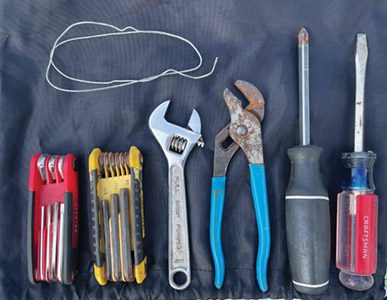
Gone are the days of a simple plastic kayak with a fixed seat and paddle and no moving parts! Todays dedicated fishing platforms are technically advanced with numerous moving parts including foot powered drive systems, deployable rudders, movable seats and accessory tracks. I mention this because many of you are launching without a tool kit and may find yourself needing one.
As a kayak fishing instructor, I’ve found myself doing on the water rod and reel repairs as the day wears. While clients are busting on fish and they are also busting gear so now it’s imperative that I carry a tool kit for on the water kayak adjustments. I’m super rough on my gear and now have a routine to address any potential problems prelaunch but still find myself in need of a tool kit on the water. Every couple of weeks I snug down every screw and tighten every nut and bolt that is reachable. Make sure to include checking any foot powered drive system hardware as they get a tremendous amount of use, and the cables or pulleys could stretch out a bit. Be prepared to adjust your rudder cables every now and then as well. If you film with an accessory boom make sure to tighten the track rails and even put in additional screws around the fixed location to keep the wobble out. If you are a saltwater angler, you should always rinse your kayak with fresh water after every trip paying special attention to the nylon mesh seats and bungee cords.
So here are a few suggestions for your tool kit: Start with a basic slotted and Phillips tip screwdriver, maybe one that is a combo of both. Next add a small adjustable crescent wrench and a pair of adjustable pliers. I keep two folding multi-hex key kits in standard and metric as well as a piece of bailing type wire that is malleable and easy to cut. If your kayak came with any model specific tools, I would include those. Of course, these tools are probably going to get exposed to the water so keep them in a dry bag. Mine are in a clear plastic pouch that I then put in a waterproof bag, and I never put them back wet. If they get exposed to salt water, rinse them in fresh water, dry and then spray with WD 40 or silicon spray to retard any rust or corrosion. Also consider adding super or crazy glue to your tool kit! Not only are these useful for quick repairs but they can be used to keep your rubber baits attached to your jigs and hook setups.
While I’m on the subject of things you should carry every kayaker should have a float bag with some essential items that include a simple traveling safety kit, toilet paper, duct tape and perhaps bug spray and sunscreen. Include these items and you may have less to worry about and more time to fish!
— It’s a Wild World – Get Out There | FishmanDan@paddlinandfishin
